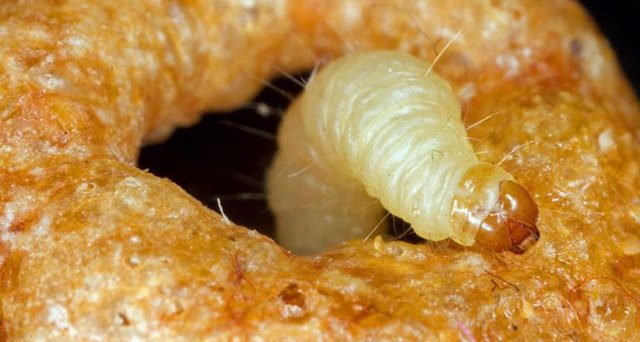The Key to Breaking Down Plastic; Caterpillars’ Guts!

ANTI-PLASTIC FANTASTIC!!
These larvae that eat plastic have diverse bacterial cocktail in their stomach. The grain-loving larvae of the moth Plodia interpunctella can be a pest in the kitchen. But the critters can also digest plastic that would otherwise take years to degrade
Caterpillars that nibble through polyethylene plastic cultivate a diverse community of digestive bacteria that process the plastic, researchers reported November 13 at the annual meeting of the Society of Environmental Toxicology and Chemistry North America. Dousing old plastic in a similar mix of bacteria might speed the breakdown of the persistent pollutant.
Polyethylene is widely used to make plastic bags and other packaging materials, but it hangs around in landfills for decades, perhaps even centuries. Recently, scientists identified several species of caterpillars that appear to eat and digest the plastic, breaking it down. But dumping old shopping bags into a den of caterpillars isn’t really a practical large-scale strategy for getting rid of the plastic. So to figure out the insects’ secret, researchers fed polyethylene to the larvae of pantry moths, Plodia interpunctella, and then looked at the bacteria in the caterpillars’ guts.
Caterpillars that ate a control diet of bran and wheat had guts mostly dominated by Turicibacter, a group of bacteria commonly found in animals’ digestive tracts. But the caterpillars that munched on the plastic had a much more diverse native microbial community. In particular, they had high levels of a few types of bacteria: Tepidimonas, Pseudomonas, Rhizobiales and Methylobacteriaceae.
Some of these bacteria have been shown to colonize and help degrade plastics in the ocean, says study coauthor Anisha Navlekar of Texas Tech University in Lubbock, so it makes sense that the microorganisms also appear to be helping the caterpillars break down plastics.
--BY LAUREL HAMERS 1:12PM, NOVEMBER 17, 2017
For more interesting finds/ posts Please Follow Me=D
upvote to help me in the struggle!
Thank you everyone!!!!!!
Interesting, I wonder if there would be a way to put this process into a worm via genetic coding somehow and then have worms that would help out our land fills around the world.
Crisper!!
Good idea, or possibly some type of creature in the ocean because there is soo much plastic at sea!